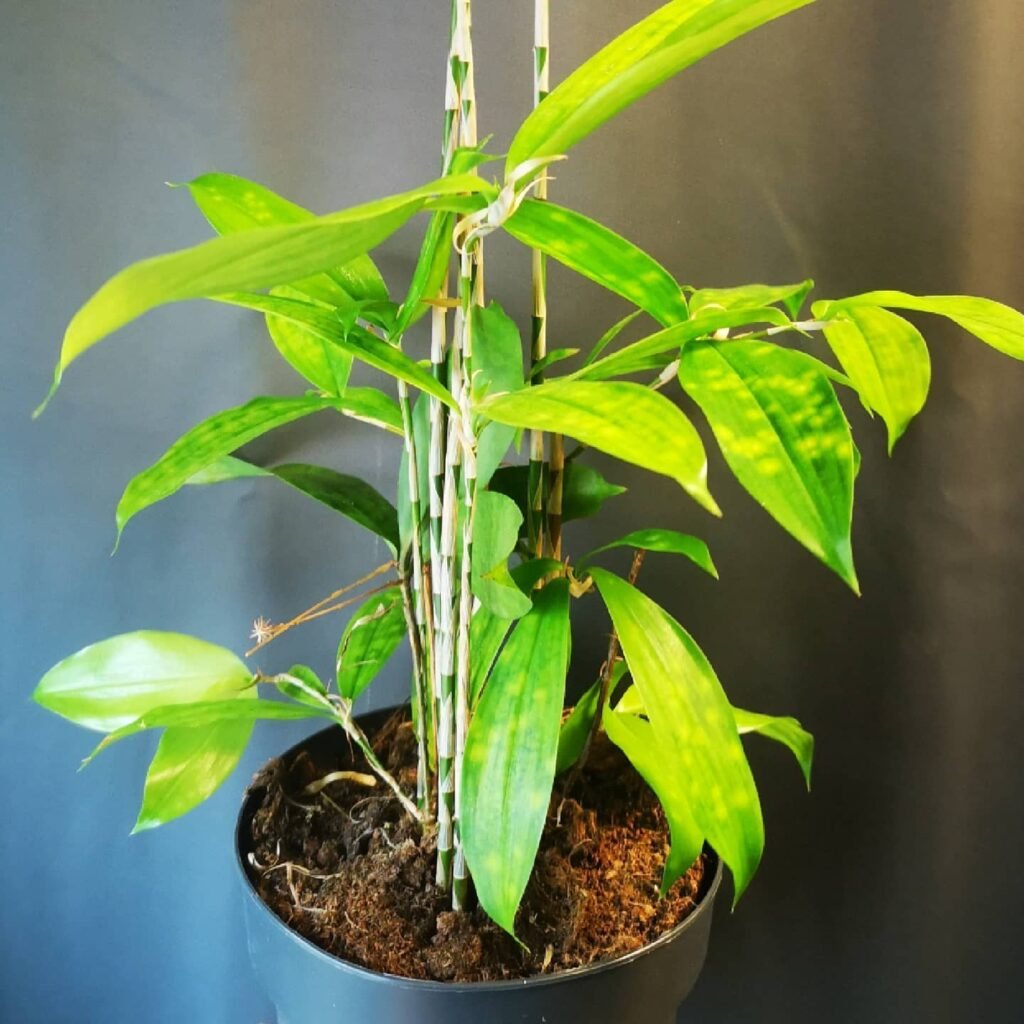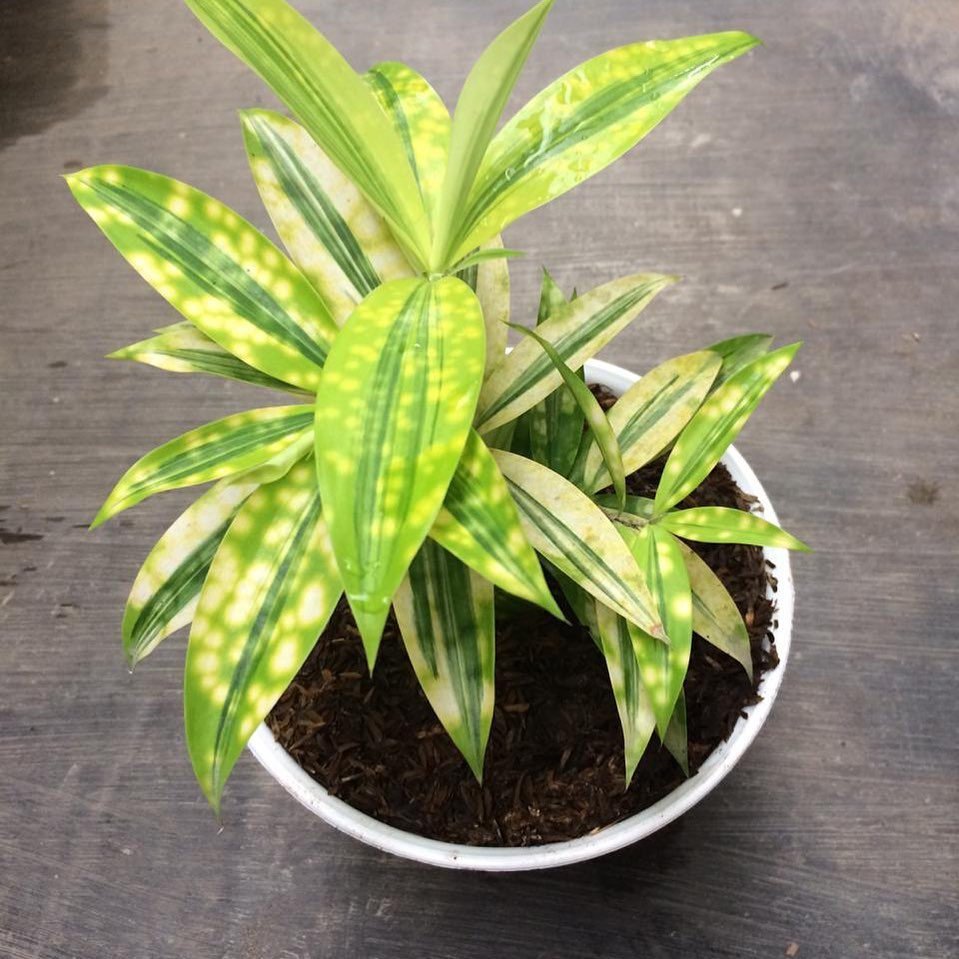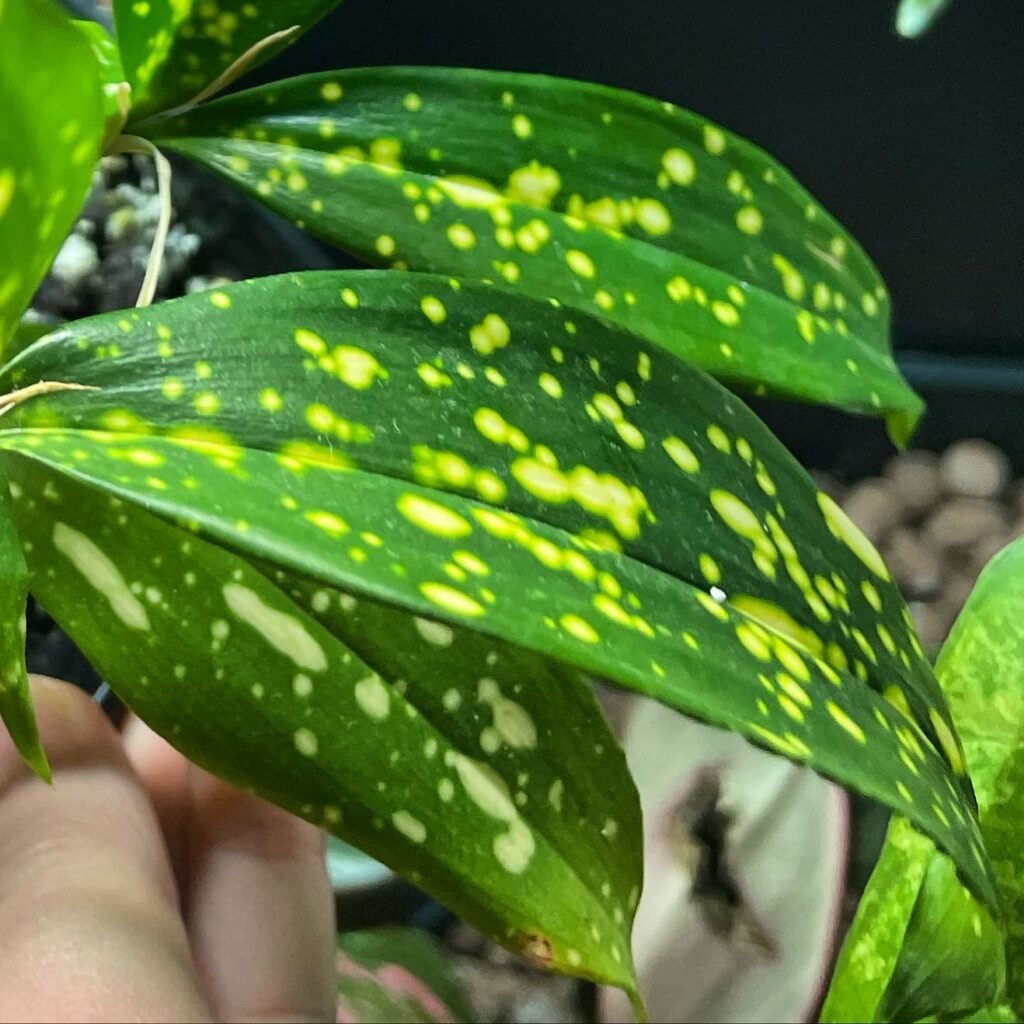With its striking appearance and unique growth patterns, this houseplant adds a touch of elegance and tranquillity to any indoor space. But caring for this beautiful plant requires specific knowledge and attention to detail. In this article, I will share essential tips and techniques for successfully nurturing Dracaena Surculosa in your UK home.
So, if you’re ready to create a lush and vibrant indoor oasis with this stunning Japanese Bamboo plant, let’s delve into the world of Dracaena Surculosa care!
Appearance of Dracaena Surculosa (Japanese Bamboo)


I admire my Dracaena Surculosa for its elegant, cane-like appearance, characterised by tall, intricately woven stalks. It stands proudly with a central stem that holds aloft pointed leaves, each strikingly variegated with cream and green stripes. When it reaches full maturity, it presents a splendid display, stretching up to 1.6 metres tall and expanding around a metre in width.
The plant comes in various varieties, each bringing its own unique twist to the Dracaena Surculosa’s charming appearance. This diversity in form and pattern enhances its allure, allowing for a personalised touch in any indoor garden.
The eye-catching foliage of Dracaena Surculosa makes it a stunning addition to indoor spaces. Its distinctive striped leaves, combined with its stately form, contribute to its popularity among plant enthusiasts. The visual impact of this plant is remarkable, offering a striking green and cream palette that can complement any room decor.
Maintaining the plant’s shape through occasional pruning not only preserves its beauty but also contributes to a neat and orderly appearance. This care ensures that Dracaena Surculosa remains a captivating feature in any setting.
With its unique appearance and the variety it offers, Dracaena Surculosa stands out as a fascinating specimen in the world of indoor plants.
 Dracaena Surculosa, known as Japanese Bamboo, isn’t true bamboo but part of the asparagus clan! Thrives in indirect light, dislikes soggy roots, and is ace at purifying air. A doddle for novices, it jazzes up spaces with its speckled leaves.
Dracaena Surculosa, known as Japanese Bamboo, isn’t true bamboo but part of the asparagus clan! Thrives in indirect light, dislikes soggy roots, and is ace at purifying air. A doddle for novices, it jazzes up spaces with its speckled leaves.
Light Requirements for Dracaena Surculosa


Dracaena Surculosa, also known as Japanese Bamboo, is an indoor plant that requires specific care to thrive. One crucial aspect of its care is providing the right amount of light.
For optimal growth, place your Dracaena Surculosa in a location that receives bright, indirect light. Avoid direct sunlight, as it can cause sunburn and harm the plant. A suitable spot could be a north, east, or west-facing windowsill, or within two meters of a south-facing window.
Avoid placing the plant in areas with low light, where you can’t comfortably read a newspaper without artificial light. Instead, choose a location that provides an hour or two of off-peak sunlight before 10am or after 4pm. This will ensure the plant receives the right amount of light for healthy growth.

Watering Tips for Dracaena Surculosa (Japanese Bamboo)


When it comes to watering your Dracaena Surculosa, it’s important to find the right balance. The plant should be watered thoroughly, but only when the top third of the soil has dried out. This will prevent over-watering, which can lead to root rot and other issues.
Dracaena Surculosa requires good levels of light, which can cause the soil to dry out more quickly. Therefore, it’s essential to monitor the moisture level and adjust your watering schedule accordingly.
In the winter months, you should reduce the frequency of watering slightly to replicate the plant’s dormancy period. This will help prevent over-watering during this time.
Under-watering your Dracaena Surculosa can result in wilting, stunted growth, and yellowed foliage. On the other hand, over-watering can lead to yellowed lower leaves, a rotten stem, and wilting. Therefore, it’s important to find the right balance and provide adequate moisture without overdoing it.

Fertilizing and Soil for Dracaena Surculosa


Proper fertilizing and soil conditions are essential for the healthy growth of Dracaena Surculosa, an indoor plant also known as Japanese Bamboo. To ensure optimal nutrition, it is recommended to fertilize the plant with a “Houseplant” labeled feed. During the spring and summer months, apply the fertilizer every four waters, while in the colder months, adjust the frequency to every six waters. This regular feeding schedule provides the plant with the necessary nutrients to thrive.
In addition to fertilizing, the choice of soil is crucial for the well-being of Dracaena Surculosa. It is important to use well-draining soil that promotes healthy root growth and prevents waterlogging. When repotting the plant every two years, select a “Houseplant” labeled compost. This type of compost is specifically formulated to support indoor plants and ensures the right balance of nutrients. Remember to choose the next-sized pot with adequate drainage holes to ensure proper root development and prevent water accumulation.
By following these guidelines for fertilizing and soil, you can provide Dracaena Surculosa with the ideal environment for its growth and well-being. By maintaining a consistent fertilization schedule and using appropriate soil, you will support the plant’s overall health and enjoy its beauty as an attractive addition to your indoor plant collection.

Pruning and Maintenance for Dracaena Surculosa


I’ve learnt that regular pruning is vital to keep my Dracaena Surculosa in tip-top condition. It not only shapes the plant and encourages fresh growth but also stops it from getting too bushy. Here’s how I go about it, broken down into simple steps for anyone just starting with houseplants:
- Pruning for Health: I always start by removing any yellow or dying leaves along with any plant debris. This step is crucial as it keeps the plant looking neat and wards off any potential diseases.
- Using the Right Tools: I make sure to use clean scissors or shears for pruning, which ensures the cuts are clean and minimises damage to the plant. This careful cutting helps the plant heal faster and better.
- Cutting Technique: When I cut, I do so just above the node – that’s the part of the stem where new growth can sprout. This encourages my Dracaena Surculosa to branch out and grow new leaves, keeping it lush and full.
Beyond pruning, I also pay close attention to the overall upkeep of my Dracaena Surculosa:
- Watering Wisely: I water the plant when the top inch of the soil feels dry to the touch, being careful not to overdo it to prevent root rot.
- Feeding Regularly: During the growing season, I feed it with a balanced houseplant fertiliser every two to four weeks, ensuring it gets all the nutrients it needs for healthy growth.

Propagating Dracaena Surculosa (Japanese Bamboo)


Dracaena Surculosa, like many indoor plants, can be propagated through different methods, such as rhizomatous division and offset division (pups). When it comes to propagation, timing is crucial for success. The ideal time to divide the plant is during the spring or summer months when the pups have reached a height of at least 8cm and have several mature leaves.
To begin the propagation process, gently brush away some soil to access the base of the pup. Cut the stem with at least two root strands attached, ensuring that you have a healthy portion of the plant to work with. This will give the pup the best chance of thriving on its own.
Next, plant the pup in a pot with well-draining soil. It’s important to use soil that allows excess water to drain away, preventing root rot. Maintain even moisture in the soil to ensure proper root development. Avoid overwatering, as this can lead to fungal diseases or root rot. It is better to slightly underwater than to overwater.
After planting the pup, it’s time to be patient and let nature take its course. It typically takes around a month or two for the pup to establish its roots and start growing as a mature plant. During this time, continue providing the necessary care, including the appropriate light, watering, and fertilizing.
Propagating Dracaena Surculosa not only gives you the opportunity to expand your collection of this beautiful plant but also allows you to share the joy of indoor gardening with others. It’s a rewarding process that gives you the satisfaction of nurturing new life and watching it grow.

Repotting Tips for Dracaena Surculosa
Repotting my Dracaena Surculosa every two years is a practice I’ve found essential for providing it with fresh nutrients and encouraging robust growth. Here are the steps I take to ensure a smooth transition:
- Choosing the Right Pot and Compost
- I always opt for a pot with good drainage to avoid waterlogging and root rot, typically one size larger than its current home. I fill it with a “Houseplant” labelled compost, which is specially formulated to give indoor plants the nutrients they need.
- Hydrating the Plant
- To make the transition easier and safeguard the roots, I water the Dracaena Surculosa thoroughly 24 hours before repotting. This ensures the roots are hydrated and more pliable.
- Removing the Plant
- I carefully lift the plant from its existing pot, easing the soil away from the edges and supporting the base with my hand or a trowel. This method helps prevent any undue stress on the plant’s stems or foliage.
- Placing in the New Pot
- In its new pot, I make sure the Dracaena Surculosa sits centrally and at the same depth as before. I then surround it with more “Houseplant” compost, pressing down gently to secure it in place.
- Watering and Settling
- After repotting, a thorough watering helps settle the compost and eliminate air pockets around the roots. I let any excess water drain away to ensure the plant isn’t sitting in moisture.
 Did you know the Dracaena Surculosa, or Japanese Bamboo, can improve air quality in your home? Studies suggest it has the ability to filter out indoor pollutants, making it not just a stylish addition to your space but a healthful one too. It’s like having a natural air purifier that also adds a touch of green to your indoors!
Did you know the Dracaena Surculosa, or Japanese Bamboo, can improve air quality in your home? Studies suggest it has the ability to filter out indoor pollutants, making it not just a stylish addition to your space but a healthful one too. It’s like having a natural air purifier that also adds a touch of green to your indoors!
Toxicity of Dracaena Surculosa
The sap of Dracaena Surculosa is toxic to animals, making it unsuitable for households with pets or young children. While not considered poisonous to humans, it is still important to exercise caution. Ingesting the sap may cause mild gastrointestinal discomfort, so it is best to avoid contact and keep the plant out of reach.
Dracaena Surculosa is a popular choice for indoor plants and houseplants, adding a touch of greenery to any space. However, it is essential to prioritize the safety of both our furry friends and little ones. To prevent any potential mishaps, keep all plants, including Dracaena Surculosa, in areas that pets and small children cannot access.
Helpful Videos about Dracaena Surculosa (Japanese Bamboo)
Considering trying your hand at Dracaena Surculosa, also known as Japanese Bamboo? I’ve compiled a series of videos just for you. These guides are packed with simple, yet effective advice to ensure your Japanese Bamboo flourishes, covering everything from essential care instructions to nifty tips. Whether you’re a seasoned gardener or just starting out, these videos are designed to make the care process for your Dracaena Surculosa as straightforward as possible, guaranteeing a splendid gardening experience.
- “Dracaena Surculosa” propagation in water & soil by stem cuttings
- How to Grow Japanese Bamboo in Water
FAQ about Caring for Dracaena Surculosa (Japanese Bamboo)

Keen on making your Dracaena Surculosa (Japanese Bamboo) look absolutely fabulous? Check out my straightforward FAQ for all the guidance and tips you’ll need to look after your Japanese Bamboo. From finding the ideal location in your home to nailing the watering routine, I’ve got everything covered to ensure your plant flourishes.
Water when the top inch of soil feels dry, typically every 1-2 weeks, depending on your home’s humidity and temperature.
Place it in a spot with bright, indirect light. Avoid direct sunlight, which can scorch the leaves.
Yes, a well-draining potting mix is ideal, such as a mix designed for cacti and succulents.
Signs of overwatering include yellowing leaves and a soggy base. Let the soil dry out more between waterings.
It can tolerate low light but thrives and shows the best colour in brighter conditions.
Repot every 2-3 years or when it outgrows its current pot, ideally in spring.
Place it on a pebble tray with water or use a humidifier, especially in dry, heated rooms.
It enjoys typical indoor temperatures, between 18°C and 24°C. Avoid cold drafts and sudden temperature changes.
Feed with a balanced, liquid houseplant fertiliser every 4-6 weeks during the growing season (spring and summer).
Snip off any brown or damaged leaves at the base, and trim back any leggy growth to encourage bushiness
Keep an eye out for spider mites and scale insects. Wipe leaves with a damp cloth regularly to prevent infestations.
Yellow leaves can be a sign of overwatering, low light, or nutrient deficiency. Assess care routines for issues.
Yes, propagate by cutting a stem section and placing it in water or directly into soil to root.
Yes, it can be harmful if ingested by pets. Keep it out of reach from cats and dogs.
Brown tips often indicate low humidity or water quality issues. Use filtered water and increase humidity.
It’s best kept indoors due to the UK’s cooler climate. It may enjoy summer outside in a shaded spot but bring it in before it gets cold.
With proper care, it can thrive for many years, often outgrowing its space before showing signs of age.
Gently wipe the leaves with a damp cloth to remove dust and help the plant breathe and absorb light more effectively.
I hope you now feel more confident about looking after your Dracaena Surculosa (Japanese Bamboo). If you’re still wondering about anything, just pop your questions in the comments. I’ll be more than happy to help out. Remember, every gardener starts somewhere, and learning about your Japanese Bamboo is all part of the fun.

